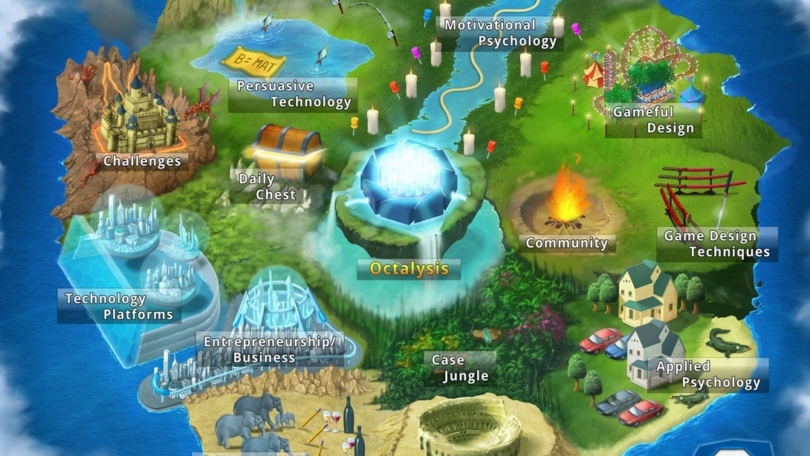There have been so many discussions about the terms gamification and gameful design that I was avoiding posting about them until now. But now I felt like giving my contribution and trying to help differentiate both terms and discuss why the difference matters.
Despite everything that has already been said about these two definitions, I feel we still not have an agreed upon differentiation between the two. Yet, a well-conceptualized differentiation was already suggested by Deterding and colleagues back in 2011; let’s take a look at what they said (p. 3):
“Gamification” will usually coincide with gameful design as defined above: The most likely strategy of designing for gameful experiences is to use game design elements, and the most likely goal of using game design elements are gameful experiences. Yet analytically, gameful design and “gamification” frame the same extension of phenomena through different intensional properties – as the design strategy of using game design elements (gamification) or the design goal of designing for gamefulness (gameful design).
Therefore, the difference between the two concepts lies in the designer’s intention. Yet, the idea of gameful design has been used many times to try to elevate the practice, as if gamification had a negative connotation whereas gameful design was more positive. Thus, gamification was often associated with poor design jobs, for example, those that only targeted short-term extrinsic motivation or those that only used the same game elements (such as points, badges, and leaderboards) over and over again. But that is not what the difference between gamification and gameful design really is. As a new practice, we can expect to see some efforts of either gamification or gameful design that result in poor products; but as the knowledge on those topics improves, we can expect to see more and more good products and less bad products. Nevertheless, even for well-established practices or professions, there will always be good and bad professionals. For example, there are good and bad engineers, but the fact that bad engineers exist who do a poor job does not make us question the name “engineering”. Similarly, there are good and bad teachers, but the fact that we see some bad teachers does not mean that we should stop calling teaching “teaching” and create a new denomination. Accordingly, the fact that some bad designers did a bad job while trying to use gamification does not mean that the name “gamification” should be dropped in favour of gameful design or any other!

Understanding the difference
Looking back at the definition from Deterding and colleagues, we can then say that someone is using gamification when they focus on using game elements as a strategy to solve a problem, which might be, for example, increasing user motivation or performance. On the other hand, we can say that someone is using gameful design when they focus on creating a gameful experience for the users. It seems obvious that a good strategy to create a gameful experience is to use proven game elements; therefore, it is very likely that gameful design will at some point employ game elements, but through the design intent of creating gameful experiences (gamefulness). In turn, gamification will probably also lead to a gameful experience, but as a result of using game elements. However, there is a catch here: the simple use of game elements does not guarantee a gameful experience. The understanding of what constitutes a gameful experience is still something that deserves more investigation (see my previous post on Suits’s understanding of what “to play a game” means, which can be helpful); however, I believe game designers would generally agree that game elements taken separately are not what create the experience, but the balanced and careful combination of them in a system that provides players with adequate goals, means, and rules that afford gamefulness. Therefore, when gamification takes individual game elements and applies them to foster motivation, it might succeed in affording motivation even if not necessarily creating a gameful experience. There lies an important difference: gamification can be successful even if the goal is met without necessarily creating a gameful experience, whereas gameful design is only successful when a gameful experience is created.
Since the difference between gamification and gameful design lies in the designer’s intention, it may not be possible to distinguish between them just by looking at a finished product. If a product uses game elements to afford a gameful experience, it might have been designed by either means. If a product uses game elements to foster motivation but does not create a gameful experience, it might have been designed following a gamification approach; but it might also have been designed using a gameful design approach that ultimately failed to create the intended gameful experience. For example, let’s look at a product like Duolingo, which I have previously used as an example: it uses game elements (such as points, progress bars, and goals) and it affords a gameful experience (by challenging the user to achieve goals through the required means, i.e., by studying a language). Therefore, we cannot know if it was designed through a gamification method or a gameful design method unless we ask the designers involved in its conception.

Does this difference really matter?
I would say that for a user, no, it does not matter at all! If a product successfully helps the user accomplish their goals, it makes no difference what design approach was used to create it. However, for designers, I would say that yes, this does matter. The practices of gamification and gameful design are beginning to mature, so at this moment we need to abandon simplistic methods that consisted only of choosing game elements from a short tlist in favour or more comprehensive methods that have a clear goal and a proven procedure to accomplish this goal. Thus, it is very important to understand this difference because gamification and gameful design methods might differ in their initial goal and intention: either focusing more on using game elements to solve a problem or envisioning a gameful experience and seeking the means to create it.
Presently, looking at the existing design methods and trying to classify them between gamification or gameful design would be a very subjective task, as no one has ever done a systematic study on this issue. But if I might be so bold as to try to classify some of the methods I am most familiar with, I would put for example Yu-kai Chou’s Octalysis framework in the group of gamification methods. The reason is that it is more focused on using game elements to achieve a goal, which is to facilitate motivation. Thus, creating a gameful experience is a secondary goal, and Octalysis can be very successful at improving motivation without necessarily creating a gameful experience. The fact that Yu-kai prefers to refer to it as “human-focused design” instead is also a hint that the gameful experience is not at the centre of the method. On the other hand, I would put Sebastian Deterding’s Lens of Intrinsic Skill Atoms and Jane McGonigal’s SuperBetter in the group of gameful design methods. The reason should be obvious: these methods focus on envisioning an intended gameful experience and then using game elements or motivational lenses as a strategy to afford this experience. I believe it is also possible to have methods that balance the different approaches and I would put Andrzej Marczewski’s Intrinsic Motivation RAMP and the User Types Hexad in this group. It is focused on motivation, but it also includes a balanced concern with the gameful experience and the use of game elements. These are just some examples and of course, there are many other design methods out there, but my intention is not to provide a taxonomy of design methods in this post (perhaps in the future). However, if you would like to know my opinion on where a particular design method would fit into this classification, let me know in the comments!
It is important to note that all methods I used as examples above are great methods, which can lead to very good results. This reinforces my point that it is not the quality of the method or product that makes the difference between gamification and gameful design, but the design intention and approach. Regarding quality, there can be good or bad gamification or gameful design methods. Thus, when we see a bad design in the future, let’s stop trying to attribute the issue to an inherent flaw of gamification, gameful design, or any other design practice, and let’s attribute it to what it really is: just a bad executed job, as it can happen in any profession.
To summarize my point, I contend that the distinction between gamification and gameful design as the design intent and approach is important when we are studying, using, and developing new design methods because we need to deeply understand what we are talking about. When comparing design methods that use different approaches, we must be careful as these methods might have different goals, even though they might look similar otherwise. When choosing a method to use, we must understand the differences and consider them carefully. There is no single approach wich is universally better. The choice of the most appropriate method for each situation depends on many factors, including the project goals and the expertise and abilities of the designers. Finally, when developing new methods, we must be aware of these differences so we can proceed with a clear understanding of what we intend to do and what solution we will propose.




6 Comments
Andrzej
I’m interested!
Carl
I like the criticality and distinctions, thanks for sharing!
This may be a very simple question that requires a simple answer, but I thought it was worth clarifying:
If the purpose of gamification is the use of game elements to solve a specific problem by fostering user motivation (intent being on a specific challenge that is goal-oriented), whats the intent for creating gameful experiences? Fun and enjoyment?
Do we have any forms of evidence to show that using game elements to achieve a specific goal is ‘better achieved’ by ALSO creating a gameful experience – as apposed to not creating a gameful experience around a gamifcation intervention?
Gustavo Tondello
These are great questions!
When we apply gameful design to a system or product, the goal is not so different from gamification. So gameful design also aims to solve a specific problem by fostering user motivation. The difference is more on the design approach than the goals and the final result. That’s why I mentioned that just by looking at the final result, we usually cannot say which approach was used by the designer, because both can lead to very similar results.
Regarding your second question, I’m not familiar with any study showing evidence that succeeding in creating a gameful experience leads to a higher chance of success in achieving the instrumental goals. That would be a very interesting study! My impression is that a design that creates a gameful experience has a greater potential in fostering motivation. However, if this is necessary or not, I believe that it depends on the context and the application. Some applications might have goals that can be more easily achieved even without a gameful experience, so the experience per se might not be so needed in these cases; whereas other applications might have goals that are more suited or more easily achievable together with a gameful experience. But while we don’t have evidence to support this or any design guidelines to follow, we have to consider each situation carefully.
Carl Eacott
Late reply, but thanks for your time in answering my questions! I think your last comment “we have to consider each situation carefully” is a key take-away point; especially in a climate of generalizability.
If you’re happy to do so, I’m keen to find out more about the research you and the HCI games group are involved with – do you have an email address to get in touch (or follow via Twitter @CarlEacott to chat further?). Thanks, Carl.
Javier Velasquez
I believe one of the ambiguities arises from using terms like “game elements” or “game thinking”, which are semantically broad and rather obscure. Gamification places an emphasis on game feedback systems and game interface components, while gameful design places the emphasis in game mechanics and rules (which includes the above). Now, an emphasis does not mean that it can’t go beyond that, and certainly our BEM framework is an approach that does not separates by methodology but by intention (¿do you want to maximize experience, learning or do you want to maximize utility?, ¿Do you need complex game rules or just game-like interfaces?).
On the other hand, gamification could be understood as the methodology to “turn something more into a game-like system” (ergo, the “-ification”), while gameful design could be “design using the principles of game design”. The thing is, probably all good “gamification designers” will use gameful design, as it expands their design toolkit and there is no reason to stick with only game feedback systems in the toolbox. There is also playful design (or what Extra Credits called Anti-Gamification) and much more. So the question, I think, should not be what are their differences, but what can they use from each other to create a better framework for engagement, experience, motivation and so on.
Gustavo Tondello
Thank you for commenting, Javier!
I believe our concepts of gamification and gameful design are slightly different, so, it was interesting to see your point of view.
And your BEM framework is very interesting because it offers many different views and different ways of approaching a project. Good job!